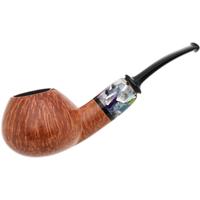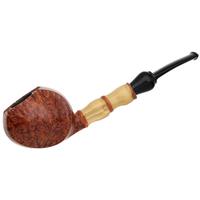Good Morning Dave,
I believe this is what you are talking about. I posted the link yesterday or the day before. Now, I will do a copy-paste;
Curing Tobacco Leaves
Why should I cure my tobacco?
Curing tobacco is a means of removing any unpleasant smell that uncured tobacco has. You can smoke your tobacco without curing it if you don't mind the smell (not unlike herbal tobacco), but I'd advise against it. Curing tobacco doesn't take long and vastly improves the smell.
During my younger years, it was common practise of mine to pick up the ripened brown tobacco leaf that had fallen from the lower stem onto the ground, roll it into a cigarette and smoke it. Other allotment holders would sample the leaf with enjoyment. I don't know if it was the oudoor air, but no unpleasant smell spoilt the smoke.
I would further mention that one particular year I was late pulling up the stems after removing all the large leaf. It was after a frost had turned all the small leaf on the plant dark brown. I tried to see if this brown tobacco leaf could be smoked: it could, with a very strong cigar flavour for both Havana and Virginia. I have never followed this idea through, but how about one of you readers of this site giving it a try?
My next attempt at curing tobacco required a greenhouse. I calculated that it would require the whole of the British summer to cure the leaf. Because of this the curing took place the following summer after growing the crop. The principle was to suspend a platic sheet holding water near the top of the greenhouse. A small fan blew across the water, raising the humidity in the air. This system worked and is shown in my instructions, but I needed a system that would work much faster. I am impatient by nature and after months of growing I needed results and a smoke that wouldn't have heads turning whenever I lit up.
To cure your tobacco leaves, you'll need a tobacco curing chamber. You should avoid using wooden tobacco curing chambers as the smell of the wood will be absorbed into the tobacco. Further down this page I give full instructions for building your own portable tobacco curing chamber, just like the one in the picture above, that will cure 18 kilos (40 pounds) of tobacco leaves in just 4 weeks. This should cost you no more than about £50 / $75 using materials from boot sales or about £100 / $US150 using new materials and equipment. This chamber can be scaled up or down depending on the size of your tobacco crop.
Historical info
Hundreds of years ago, tobacco was smoked in pipes or was ground into snuff to be rubbed into the gums. Tobacco curing was unheard of. Tobacco wasn't smoked as cigarettes until cheap paper became available. The tobacco smoked back then must have smelled because it hadn't been cured.
The first clues to curing tobacco came from the old sailing ships that brought tobacco to Europe from the West Indies. The ships were in at sea for several weeks with tobacco on board. They were also in port for two or three weeks while the tobacco was loaded and unloaded. The heat and humidity were high and together with the salt air caused a natural fermentation in the bails of tobacco. By the time the tobacco reached our shores it was partially cured. From this, many different techniques for curing tobacco have been developed.
The copy-paste is too long so I will do it in portions....
Drying and Colour Curing
The first stages in curing your tobacco leaves are the drying and colour curing of your tobacco to remove moisture and turn the leaf brown. Your tobacco leaves are about 90% moisture, so while each plant can give you 1 kilo (2 pounds) of tobacco leaves, the dried weight is only about 100 grams. Whilst drying, Virginia tobacco leaves will turn yellow and then brown. Green stemmed tobacco plants such as Havanna take longer to colour change and tend to go straight from green to brown.
Commercial tobacco companies put their tobacco leaves in large open-ended barns to allow the warm breeze to blow through and draw off the moisture. For the home grower, you can hang your tobacco leaves on canes or galvanised wire in a car port or other sheltered outdoor area. I normally hang my tobacco under overhead grapevines which shelter the tobacco leaves from the rain.
You can dry your tobacco indoors, but control the temperature carefully to avoid drying the tobacco too quickly. If you dry your tobacco too quickly, some of the green pigment may remain. The drying and colour curing of your tobacco is complete when the tobacco leaves have turned brown, and the mid-rib is bone dry and brittle.
There is no quick way to dry out your tobacco leaves. Ovens, microwaves and freezers do not really help and the best way to dry and colour cure your tobacco is to dry it naturally. You can speed up the process slightly by crushing the mid-rib, but be warned that the sap in the mid-rib is like an acid to the other tobacco leaves. If you crush the mid-rib, you must hang your tobacco up within a couple of hours.
Another way to speed up the drying and colour change process of your tobacco leaves is to stack them and cover them with a blanket or a rug to keep the heat in. The tobacco leaves will then sweat like compost, which speeds up the colour change. The pile needs turning daily, with the inner leaves moved to the outside. Damp leaves will need to be allowed to dry off before being put back into the pile. After about 5 days, the tobacco leaves can be hung out to dry as normal.
You could also lay the tobacco leaves out on the grass on a hot sunny day and they will dry within hours. Depending on the temperature, the humidity and the breeze, green leaves will turn yellow or yellow/brown, and yellow leaves will turn brown. You may be lucky enough to have green leaves turn completely brown. The main drawback to this method is that because the leaves are drying, they are losing their moisture. This makes them much lighter and one small gust of wind can carry your dried tobacco leaves away.
Building a Tobacco Curing Chamber and Curing Your Tobacco
Over the many years that I've been growing tobacco, I've experimented with many different methods of curing tobacco. As a result of this experience, I can now provide you with instructions for building your own very cheap and very effective portable tobacco curing chamber. This will cure about 18 kilos (40 pounds) of tobacco leaves in as little as 4 weeks and should cost you no more than £100 / $US150 using new materials and equipment, or half that if you use second-hand materials and equipment.
The aim of curing tobacco is to sweat the obnoxious smell from the tobacco leaves. To make tobacco leaves sweat you need to create a warm and humid environment. My portable tobacco curing chamber is ideal for this.
For the sides of the tobacco curing chamber, I used sheets of 2-inch thick polystyrene. 3 sheets of 8ft x 4ft polystyrene will be enough to build a tobacco curing chamber measuring 1 metre square by 1 and a half metres high. This cost me about £29 (US$50) from my local hardware store. You can build a smaller curing chamber if you don't have much space, but you won't be able to cure as much tobacco.
To provide heat, I used an oil-filled electric heater. This ideally needs to run at a constant 130°f (54.5°C).You will find most oil-filled electric heaters will have thermostats set to cut out at much lower temperatures. You should be able to replace the thermostat on oil filled radiators with a clamp-on water heater thermostat. These cost about £12 (US$18) from your local hardware store. You can heat at lower temperatures, but your tobacco will take much longer to cure.
Moisture needs to be raised inside the tobacco curing chamber to keep the leaf flexible but not wet. A humidifier is ideal for this. Humidifiers are little more than water tanks with a fan to blow a fine mist of water into the air. Mine holds 6 litres of water and uses 5 litres every 24 hours.
Hold the base, sides and top of the curing chamber together with double sided carpet tape or other strong tapes. Cut an opening in one side to act as a door. Use tape as a hinge to keep the door closed.
Finally, drill a 2 inch hole at the base of the chamber to allow fresh air in and another hole near the top to allow the smell to escape. If you fit a length of hose from the top hole to outdoors then the smell can escape without affecting your home.
When the unpleasant smell has gone, your tobacco has cured and is ready to smoke, although leaving your tobacco to mature over the years will improve the tobacco flavour. The whole tobacco curing process should take about 4 weeks. The cost of running the curing chamber is minimal as the chamber is made from thick polystyrene which will retain heat. The thermostat on the heater inside the curing chamber will cut in and out only as required, so only minimal heat is required. Humidifiers cost very little to run.
I hope this helps everyone.















